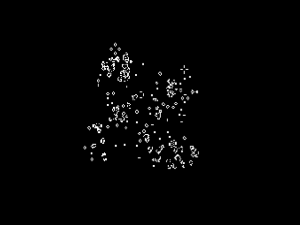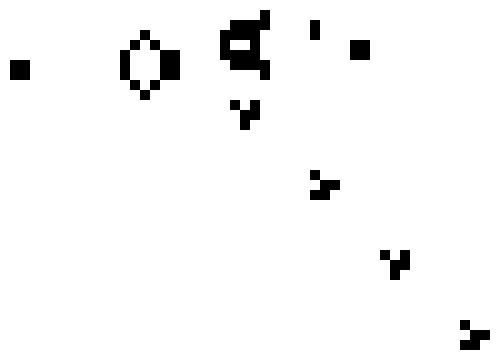No edit summary |
No edit summary |
||
| (6 intermediate revisions by the same user not shown) | |||
| Line 1: | Line 1: | ||
{{Infobox Wii Homebrews | {{Infobox Wii Homebrews | ||
|title=WiiLife | |title=WiiLife | ||
|image= | |image=wiilife2.png | ||
|description=Also cellular automata | |description=Also cellular automata. | ||
|author=drei000 | |author=drei000 | ||
|lastupdated=2009/01/04 | |lastupdated=2009/01/04 | ||
| Line 14: | Line 8: | ||
|version=20080728 | |version=20080728 | ||
|license=Currently Freeware | |license=Currently Freeware | ||
|download=https://dlhb.gamebrew.org/wiihomebrews/ | |download=https://dlhb.gamebrew.org/wiihomebrews/wiilife.7z | ||
|website= | |website=https://wiibrew.org/wiki/WiiLife | ||
}} | }} | ||
WiiLife is an adaptation of [http://en.wikipedia.org/wiki/Conway's_Game_of_Life Conway's Game of Life] for the Nintendo Wii. It allows users to observe the evolution and death of a random population of cells. | |||
The game features zooming and scrolling capabilities, and also allows users to create new random populations or test out their own patterns. | |||
== User guide== | |||
The Game of Life, devised by British mathematician John Horton Conway in 1970, is a cellular automaton that is considered the most well-known example of its kind. It is a zero-player game, where the evolution of the game is determined by its initial state, and no input is required from human players. | |||
The Game of Life is played by creating an initial configuration and observing how it evolves over time. The game takes place on an infinite two-dimensional grid of square cells, with each cell being in one of two states, alive or dead. Each cell interacts with its eight neighboring cells, which are those that are horizontally, vertically, or diagonally adjacent. At each step in time, the following rules are applied: | |||
* Any live cell with fewer than two live neighbours dies, as if by loneliness. | |||
* Any live cell with more than three live neighbours dies, as if by overcrowding. | |||
* Any live cell with two or three live neighbours lives, unchanged, to the next generation. | |||
* Any dead cell with exactly three live neighbours comes to life. | |||
The initial pattern is known as the seed of the system, and the rules are applied repeatedly to create subsequent generations. | |||
== Controls == | |||
D-Pad - Move around while zooming | |||
A - Edit Mode On/Off | |||
B - (Normal Mode) Generate new (random) population, (Edit Mode) Set/Unset Cell | |||
Plus/Minus - Zoom In/Out | |||
1/2 - Decrease/Increase Speed | |||
B+D-Pad - Change size of randomly populated area | |||
B+Plus/Minus - Change cell density | |||
Home - Quit | |||
== Screenshots == | == Screenshots == | ||
Taking Screenshots doesn't work at the moment | Taking Screenshots doesn't work at the moment, but it looks quite similar to this, just the colors inverted. | ||
https://dlhb.gamebrew.org/wiihomebrews/ | https://dlhb.gamebrew.org/wiihomebrews/wiilife3.gif | ||
==Known issues== | |||
The program may occasionally crash. | |||
== Changelog == | == Changelog == | ||
'''2008 | '''2008/07/28''' | ||
* Edit Mode finally here. Press A and draw Cells by Point&Click. Press A again and see what happens. | |||
'''2008 | |||
'''2008/07/27''' | |||
*Adjustable Cell density and size of randomly populated area. | |||
'''2008 | '''2008/07/26''' | ||
*icon.png and meta.xml added to .zip. | |||
*Speed can now be slowed down and speed up again (starting speed is maximum speed at the moment). | |||
*Initial pattern changed to [http://en.wikipedia.org/wiki/Glider_gun Gosper's Glider Gun]. | |||
*Fewer living cells in random populations. | |||
'''2008/07/25''' | |||
* | *Initial Release / edit: resized the area where cells start so that they have some space to evolve. | ||
==External links== | ==External links== | ||
* | *WiiBrew - https://wiibrew.org/wiki/WiiLife | ||
Latest revision as of 09:56, 25 February 2023
| WiiLife | |
|---|---|
 | |
| General | |
| Author | drei000 |
| Type | Math |
| Version | 20080728 |
| License | Currently Freeware |
| Last Updated | 2009/01/04 |
| Links | |
| Download | |
| Website | |
WiiLife is an adaptation of Conway's Game of Life for the Nintendo Wii. It allows users to observe the evolution and death of a random population of cells.
The game features zooming and scrolling capabilities, and also allows users to create new random populations or test out their own patterns.
User guide
The Game of Life, devised by British mathematician John Horton Conway in 1970, is a cellular automaton that is considered the most well-known example of its kind. It is a zero-player game, where the evolution of the game is determined by its initial state, and no input is required from human players.
The Game of Life is played by creating an initial configuration and observing how it evolves over time. The game takes place on an infinite two-dimensional grid of square cells, with each cell being in one of two states, alive or dead. Each cell interacts with its eight neighboring cells, which are those that are horizontally, vertically, or diagonally adjacent. At each step in time, the following rules are applied:
- Any live cell with fewer than two live neighbours dies, as if by loneliness.
- Any live cell with more than three live neighbours dies, as if by overcrowding.
- Any live cell with two or three live neighbours lives, unchanged, to the next generation.
- Any dead cell with exactly three live neighbours comes to life.
The initial pattern is known as the seed of the system, and the rules are applied repeatedly to create subsequent generations.
Controls
D-Pad - Move around while zooming
A - Edit Mode On/Off
B - (Normal Mode) Generate new (random) population, (Edit Mode) Set/Unset Cell
Plus/Minus - Zoom In/Out
1/2 - Decrease/Increase Speed
B+D-Pad - Change size of randomly populated area
B+Plus/Minus - Change cell density
Home - Quit
Screenshots
Taking Screenshots doesn't work at the moment, but it looks quite similar to this, just the colors inverted.

Known issues
The program may occasionally crash.
Changelog
2008/07/28
- Edit Mode finally here. Press A and draw Cells by Point&Click. Press A again and see what happens.
2008/07/27
- Adjustable Cell density and size of randomly populated area.
2008/07/26
- icon.png and meta.xml added to .zip.
- Speed can now be slowed down and speed up again (starting speed is maximum speed at the moment).
- Initial pattern changed to Gosper's Glider Gun.
- Fewer living cells in random populations.
2008/07/25
- Initial Release / edit: resized the area where cells start so that they have some space to evolve.
External links
- WiiBrew - https://wiibrew.org/wiki/WiiLife